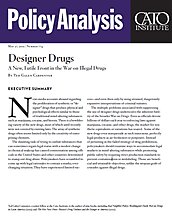The daunting task of trying to outlaw substances that can sometimes regain legal status with a modest change in chemical makeup has caused consternation among officials in the United States and other countries determined to stamp out drug abuse. Policymakers have scrambled to come up with legal rationales to contain a murky, everchanging situation. They have experienced limited success — and even then only by using strained, dangerously expansive interpretations of criminal statutes.
The multiple problems associated with suppressing the use of designer drugs underscore the inherent futility of the broader War on Drugs. Even as officials devote billions of dollars each year to enforcing laws against marijuana, cocaine, and other drugs, the market for synthetic equivalents or variations has soared. Some of the new drugs even masquerade as such innocuous, perfectly legal products as air fresheners or potpourri. Instead of persisting in the failed strategy of drug prohibition, policymakers should examine ways to accommodate legal markets in mind-altering substances while promoting public safety by requiring strict production standards to prevent contamination or mislabeling. Those are beneficial and attainable objectives, unlike the utopian goals of crusades against illegal drugs.

